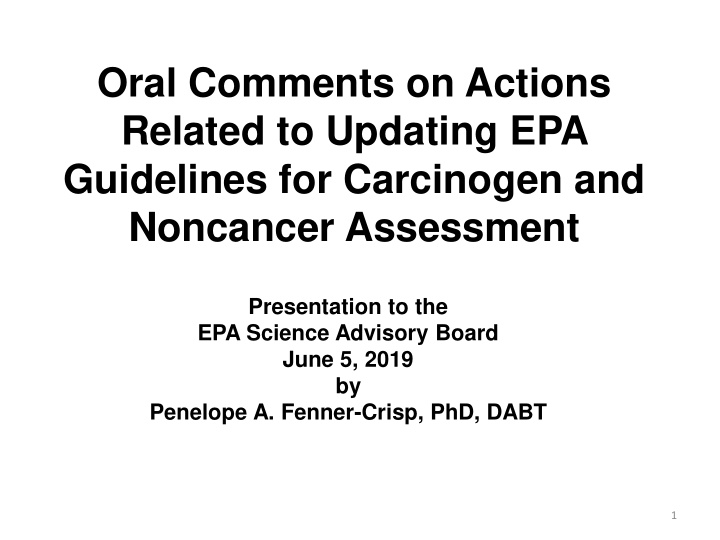



Oral Comments on Actions Related to Updating EPA Guidelines for Carcinogen and Noncancer Assessment Presentation to the EPA Science Advisory Board June 5, 2019 by Penelope A. Fenner-Crisp, PhD, DABT 1
Conclusions • EPA should develop a realistic plan and request a formal review of that plan by the SAB before proceeding (Step 1). • It is realistic to plan for a 4-6 year process, at a minimum. Finishing by the end of 2020 is wholly unrealistic. • Begin implementation by addressing the unresolved issues from the 2009 NRC Science and Decisions report before writing any guidelines. 2
Conclusions • Adequate agency resources and time need to be committed and sustained along with credible engagement of outside experts in both development and review roles. • It would be wise to engage the NAS in the review of the Science and Decisions - related issue papers, the guidelines and the qualifications of the SAB review panel to confirm that the outputs reflect an objective view of the state of the science . 3
Steps 1 . Development of Action Plans in consultation with the SAB and other key players 2. Drafting, with engaged external peer involvement 3. Discussions in public forums 4. Internal review and sign-off 5. Executive Branch (EB) reviews (guidelines only?) 6. Revision in response to EB reviews 7. Referral to NAS 8. Revision in response to NAS review 9. SAB peer review and public comment 10. Revision and response-to-comments 11. Internal review and sign-off 12. Publication of final issue papers and guidelines 4
Timelines • Science and Decisions issue papers: An optimistic timeline might be 2 ½-3 years, but a more realistic estimate would be 3-3½ years. • Guidelines: An optimistic timeline might be 3-3½ years, but a more realistic estimate would be 4-5 years. • Both tasks done in concert with no significant hurdles: 4-5 years. More realistic estimate, because unanticipated hurdles always arise: 5-6 years. 5
Recommend
More recommend